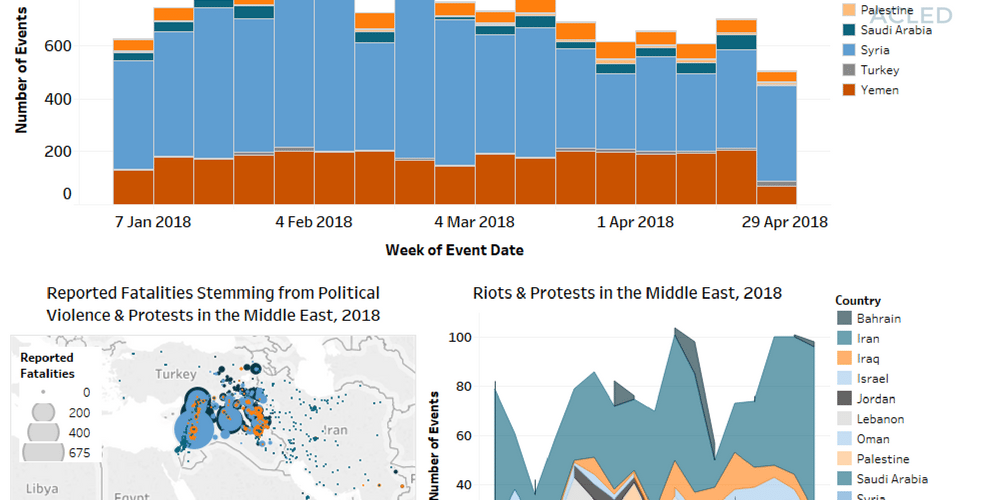The number of political violence events recorded in Iraq, Israel, Lebanon, and Palestine dropped this week, while the number of events in Bahrain and Turkey rose considerably. Meanwhile Syria is seeing a renewed focus by various forces on fighting the Islamic State, while fighting remains roughly static in Yemen.
In Iraq, a discernible lull in events was recorded last week. This is believed to be partly explained by alleged preparations being made by Islamic State militants ahead of major attacks on the upcoming Iraqi elections (Voice of America, April 20, 2018; BasNews, April 23, 2018), which are due to take place on May 12. In line with this, an overall increase in the number of election-related attacks by IS militants was also recorded.
In Bahrain, a number of peaceful marches were held last week in response to a military court’s sentencing of six people to death for allegedly forming a “terrorist cell and plotting to assassinate a military official” (Reuters, April 26, 2018). Bahrain’s king however commuted the death sentences to life in prison shortly after the demonstrations (Bahrain News Agency, April 29, 2018).
In Palestine, the Great Return March (GRM) demonstrations seeking to reaffirm the right of return for Palestinian refugees in Gaza have continued to dominate the headlines. The Israel Security Agency (ISA, or Shin Bet) also released new statistics on the increase in hate crimes by “far-right activists” targeting Palestinians, including an increase in the number of “price tag” attacks (Times of Israel, April 22, 2018). These are events involving settlers using graffiti to vandalize Palestinian property, usually with slogans, with the activity usually attributed to Jewish extremist groups (Haaretz, May 1, 2018).
In Syria, clashes between the Syrian military, backed by Russian forces, and Islamic State (IS) and Hayat Tahrir al-Sham (HTS) fighters in and around southern Damascus city have resulted in major advances in the IS-held al-Qadam neighbourhood. Meanwhile, weeks of violent clashes between HTS and the factions of the Syria Liberation Front (JTS) in Idleb and western Aleppo have given way a permanent ceasefire agreement, including the beginning of prisoner exchanges. The Global Coalition and Syrian Democratic Forces (SDF) have also begun mobilizing in southern al-Hasakeh and eastern Deir-ez-Zor for a renewed offensive against IS in the area, although this has since led to conflict with Syrian government-aligned forces in the area (Reuters, April 29, 2018).
In Yemen, protests were reported in both Hudayda and Sana’a, where demonstrators denounced the killing of Saleh al-Samad, former President of the Supreme Political Council and Houthi political leader, who died on April 19 of this year after being hit by a Saudi-led coalition airstrike (The National, April 28, 2018). Airstrikes conducted last week by the Saudi-led coalition also resulted in a higher number of civilians fatalities than the average week. In Hajjah alone, airstrikes killed a reported 40 civilians. Meanwhile, following the killing of a Lebanese Red Cross worker in Taiz, government officials ordered new operations against Al Qaeda in the Arabian Peninsula (AQAP)-linked militant groups, sparking violent clashes that remain ongoing.
AnalysisCivilians At RiskConflict MonitoringCurrent HotspotsMiddle EastRemote ViolenceRioting And ProtestsViolence Against Civilians







